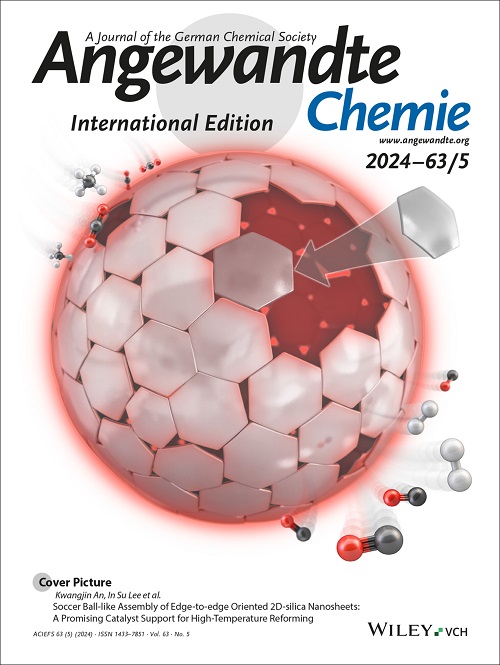A Homobimetallic Frustrated Lewis Pair Cobalt Catalyst for the Methanolysis of Hydrosilanes.
IF 16.1
1区 化学
Q1 CHEMISTRY, MULTIDISCIPLINARY
引用次数: 0
Abstract
The bimetallic Co(I)/Co(-I) complex [Co(CO)2(κ3-P,N,P-PNHP)][Co(CO)4] (1) has shown excellent activities in the methanolysis of hydrosilanes, surpassing the related bimetallic Co(I)/Co(-I) complex [Co(CO)(PMe2Ph)(κ3-P,N,P-PNHP)][Co(CO)4] (2), the Co(II) complex [Co(Cl)2(κ3-P,N,P-PNHP)] (3), and the Co(I) complex [Co(CO)2(κ3-P,N,P-PNHP)]Cl (4). A comprehensive DFT study of the plausible reaction mechanisms indicates that the enhanced activity of 1 can be attributed to the presence of the [Co(CO)4]- anion, which enables a frustrated Lewis pair (FLP) mechanism that provides a low energy pathway for the heterolytic splitting of the Si-H bond. The reaction mechanism entails the coordination of the hydrosilane to the Co(I) center upon decoordination of the amine functionality of the PNHP ligand, followed by heterolytic splitting of the Si-H bond with the participation of the Co(I) and Co(-I) centers. Then, the PhSiH2 group at the Co(-I) center is transferred to the oxygen atom of a methanol molecule, which affords the [H2SiPh(HOMe)]+ cation, regenerating the [Co(CO)4]- species. [H2SiPh(HOMe)]+ protonates the hydride at the Co(I) center, leading to the formation of H2 and the corresponding silyl ether. Alternative reaction pathways, including alternative ionic mechanisms or NH-assisted bifunctional mechanisms, result in higher activation energies.氢硅烷甲醇解用同双金属挫折Lewis对钴催化剂。
双金属Co(I)/Co(I)配合物[Co(Co)2(κ3-P,N,P-PNHP)][Co(Co)4](1)在氢硅烷的甲醇分解中表现出优异的活性,超过了相关的双金属Co(I)/Co(I)配合物[Co(Co)(PMe2Ph)(κ3-P,N,P-PNHP)][Co(Co)4] (2), Co(II)配合物[Co(Cl)2(κ3-P,N,P-PNHP)](3)和Co(I)配合物[Co(Co)2(κ3-P,N,P-PNHP)]Cl(4))。对可能的反应机制进行的综合DFT研究表明,1活性的增强可归因于[Co(Co)4]-阴离子的存在,这使得受挫的路易斯对(FLP)机制为Si-H键的异裂提供了低能途径。反应机理是氢硅烷在PNHP配体的胺官能团配位后与Co(I)中心配位,然后在Co(I)和Co(I)中心的参与下使Si-H键发生异裂。然后,Co(i)中心的PhSiH2基团转移到甲醇分子的氧原子上,提供[H2SiPh(HOMe)]+阳离子,再生[Co(Co)4]-。[H2SiPh(HOMe)]+使Co(I)中心的氢化物发生质子化,生成H2和相应的硅基醚。不同的反应途径,包括不同的离子机制或氢离子辅助的双功能机制,导致更高的活化能。
本文章由计算机程序翻译,如有差异,请以英文原文为准。
求助全文
约1分钟内获得全文
求助全文
来源期刊
CiteScore
26.60
自引率
6.60%
发文量
3549
审稿时长
1.5 months
期刊介绍:
Angewandte Chemie, a journal of the German Chemical Society (GDCh), maintains a leading position among scholarly journals in general chemistry with an impressive Impact Factor of 16.6 (2022 Journal Citation Reports, Clarivate, 2023). Published weekly in a reader-friendly format, it features new articles almost every day. Established in 1887, Angewandte Chemie is a prominent chemistry journal, offering a dynamic blend of Review-type articles, Highlights, Communications, and Research Articles on a weekly basis, making it unique in the field.

 求助内容:
求助内容: 应助结果提醒方式:
应助结果提醒方式:


